
Specifications and Features
The following table gives detailed information
about the specs of the screen:
|
Monitor
Specifications |
|
Size |
24.1"WS (61.0cm) |
Panel Coating |
Light AG coating |
|
Aspect Ratio |
16:10 |
Interfaces |
DisplayPort, Mini DisplayPort, HDMI,
DVI, D-sub |
|
Resolution |
1920 x 1200 |
|
Pixel Pitch |
0.2700 mm |
Design
colour |
Matte black bezel, stand and base |
|
Response Time |
5ms G2G (12ms ISO) |
Ergonomics |
Tilt, 150mm height, swivel and rotate |
|
Static Contrast Ratio |
1000:1 |
|
Dynamic Contrast Ratio |
20 million:1 |
VESA Compatible |
Yes 100mm |
|
Brightness |
350 |
Accessories |
Monitor hood, factory calibration report.
Cables for USB, DVI, VGA, DisplayPort > Mini DP and power |
|
Viewing Angles |
178 / 178 |
|
Panel Technology |
LG.Display AH-IPS |
Weight |
monitor with stand (without hood): 7.0Kg |
|
Backlight Technology |
GB-r-LED |
Physical Dimensions |
(WxHxD, without hood)
555.4 x 542.6 x 254.0 mm |
|
Colour Depth |
1.07b (8-bit+FRC) |
|
Refresh Rate |
60Hz |
Special
Features |
2x
USB 3.0 ports, card reader, hardware calibration, 14-bit 3D LUT, factory
calibration, uniformity correction, ambient light sensor, human sensor |
|
Colour Gamut |
Wide gamut
100%
sRGB, 104% NTSC, 99% Adobe RGB |
The BenQ PG2401PT offers a
very wide set of connectivity options for modern uses which was great to see.
All the major connection variations are included, with DVI, D-sub (VGA), HDMI,
DisplayPort and Mini DisplayPort offered. In the box the cables are provided for
power, DVI, D-sub and DisplayPort > Mini DP. The HDMI cable is not provided
however.
The screen has an integrated power supply and so
it only needs a standard kettle lead. There is a
built-in 2 port USB 3.0 hub as well on this model, with both on the left hand
side of the screen for easy access. The ports are the latest USB
3.0 generation which is pleasing.
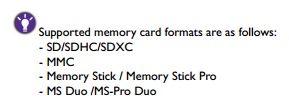
The screen also has an 8-in-1 card reader which is
also located on the left hand edge of the screen. There are also ambient light
and human motion sensors available which can be of practical use, especially in
office environments. A monitor hood is also packaged in the box for those who
need it. The only thing missing (although not missed!) are
integrated speakers. BenQ have done a great job providing all the extras and
features you could really want.
Below is a summary of the features and connections
of the screen:
|
Feature |
Yes / No |
Feature |
Yes / No |
|
Tilt adjust |
 |
DVI |
 |
|
Height adjust |
 |
HDMI |
 |
|
Swivel adjust |
 |
D-sub |
 |
|
Rotate adjust |
 |
DisplayPort |
 |
|
VESA compliant |
 |
Component |
 |
|
USB Ports |
 |
Composite |
 |
|
Card Reader |
 |
Audio connection |
 |
|
Ambient Light Sensor |
 |
HDCP Support |
 |
|
Touch Screen |
 |
MHL Support |
 |
|
Hardware calibration |
 |
Integrated Speakers |
 |
|
Uniformity correction |
 |
PiP / PbP |
 |

Design and Ergonomics
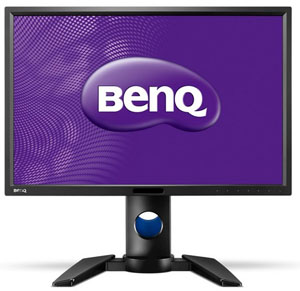
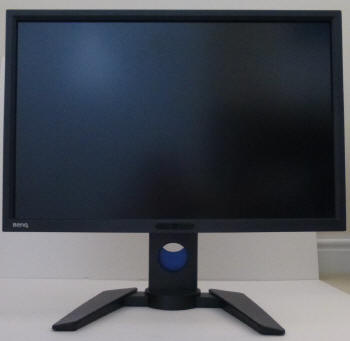
Above: front views of the screen. Click for larger version (right)
The PG2401PT comes in a mostly black design,
with some blue highlights in places. The bezel and stand are a matte black
plastic and there is a BenQ logo in the bottom left hand corner. The bezel
measures ~16mm thickness along the top and side edges, and ~21mm along the
bottom edge. In the middle of the lower bezel is a shiny black section
which contains the human motion and ambient light sensors. Plastics and
build quality are good.


Above: rear views of the screen. Click for larger versions
The rear of the screen is again a matte
black plastic. The stand is easily attached and detached and provides a
nice sturdy base for the screen. On the back of the screen you may notice
a small blue headphone hook, and the cable tidy hole also has a blue
retractable trim which looks nice. A view of the screen with the supplied
monitor hood is also provided above.
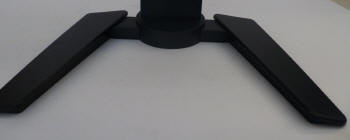
Above: view
of the stand base. Click for larger version
The base of the stand is a V shape but
provides a nice sturdy base for the screen on the whole. The screen
wobbles a little bit when knocked but nothing too bad.
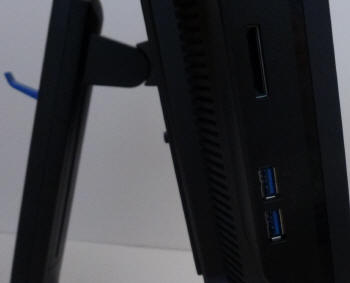
Above: view
of the side USB ports and card reader. Click for larger version
The left hand edge of the screen has two USB
3.0 ports and the 8-in-1 card reader for easy access.
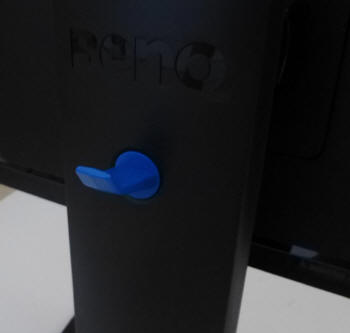
Above: view
of the headphone hook on the back. Click for larger version
The headphone clip is shown above and can be
easily removed if you want.

The stand provides a full range of ergonomic
adjustments which is good to see.
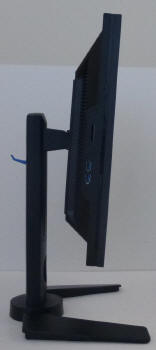
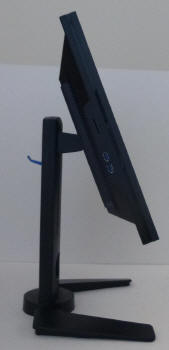
Above: full
range of tilt adjustments shown. Click for larger version
The tilt function is smooth and easy to
operate and provides a good adjustment range.
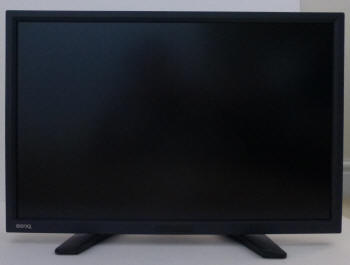
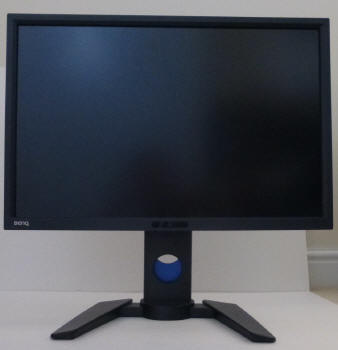
Above: full
range of height adjustments shown. Click for larger version
The height adjustment range is very good
although it's a little stiffer to operate. The movement is smooth though.
At the minimum setting the bottom edge of the screen is ~16 mm above the
top edge of the desk, which is basically when the bottom of the screen
touches the base of the stand. It can go a bit lower if the screen is
tilted forward. At maximum height adjustment it is ~163 mm from the edge
of the desk so gives you a useable adjustment range of ~147mm when the
screen itself is vertical.
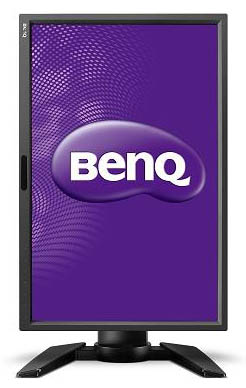
Above:
rotated portrait adjustment
shown
The side to side swivel adjustment is smooth
and easy to use, and the base remains stationary on the desk when you move
it. The rotation adjustment is also nice and easy to use and offers a
smooth movement. Great to see a full range of options from the stand here.
A summary of the screens ergonomic adjustments
is shown below:
|
Function |
Range |
Smoothness |
Ease of Use |
|
Tilt |
Yes |
Smooth |
Easy |
|
Height |
147mm |
Smooth |
Quite stiff |
|
Swivel |
Yes |
Smooth |
Very easy |
|
Rotate |
Yes |
Smooth |
Easy |
|
Overall |
Very good range of adjustments and easy to use |
The materials were of a good standard and the
build quality felt good as well. There was no audible noise from the screen,
even when conducting specific tests which can often identify buzzing issues.
The whole screen remained pretty cool even during prolonged use as well which
was pleasing.

Above: all
interface connections shown
The interface options on the back of the
screen are shown above. There is a power on/off switch and power input on the
left. Then there are audio, Mini DisplayPort, DisplayPort, DVI, HDMI and D-sub
connections available. The USB upstream port is on the right hand side as
well.

OSD Menu
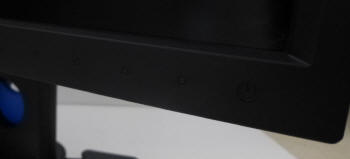
Above: views of
OSD operational buttons on the bottom right hand edge of the screen. Click for
larger version
The OSD menu is controlled from a series of 6
touch-sensitive buttons on the lower right hand edge of the front bezel. There
are 6 small etched circles on the front bezel to mark where the controls are.
There is also a
touch-sensitive power button which
glows white during operation and pulsates on and off (white) during standby.

If you hover your finger near any of the buttons
they all light up as they have proximity sensors. Pressing any of the buttons pops up the quick
launch menu as shown above just above where the buttons are on the screen. You
can change from within the main OSD what the first 4 options are using the
"custom key" options. Here we have quick access to input selection, preset
modes, brightness and contrast. There is then access to the main OSD menu. The
buttons aren't labelled so you do need to remember what each of the symbols
represents. They are pretty logical though thankfully.
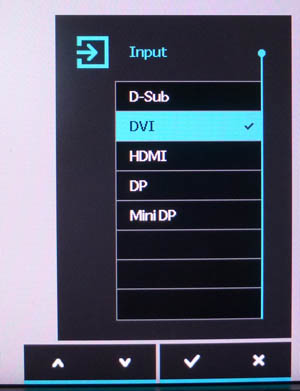
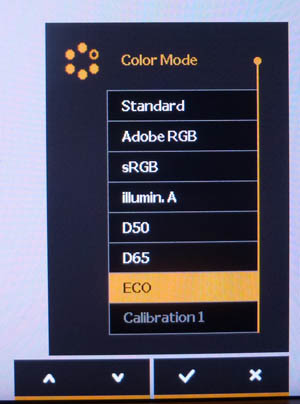
The quick launch menus pop up as shown above for
the input and preset mode menu. There is no "auto detect" option within the
input menu so you do have to manually switch to the input you want to use.
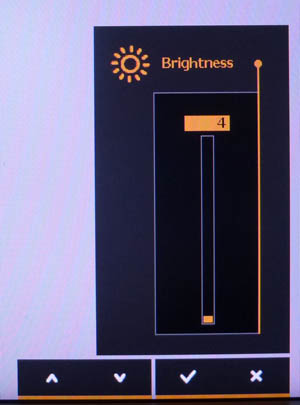
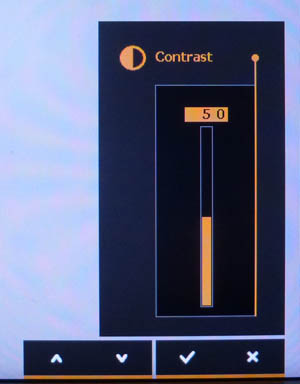
Also the brightness and contrast menus are shown
above.
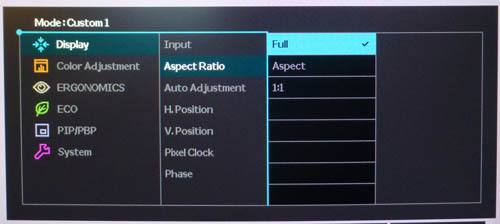
Bringing up the main OSD gives you the above. The
menu is split into 6 sections down the left hand side and the options available
within it are listed on the right. The first section is the 'display' menu where
you can control the input selection, aspect ratio control (options for full,
aspect and 1:1) and various things related to an analogue input signal. A nice
touch we felt was that each section of the menu is colour coded which helps
highlight which menu you are currently using, in this case it's a light blue
colour.
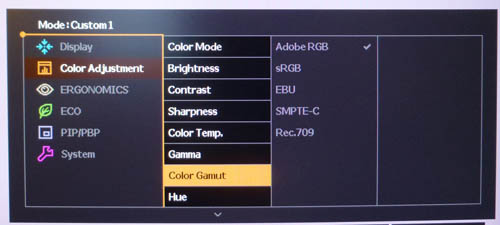
The second section is the 'color adjustment' menu.
Here there are options for various things including the preset modes (color mode
option), brightness, contrast, colour temp, gamma and colour gamut. The gamut
menu is pictured above. You can also scroll down further within this section
where more options are available:
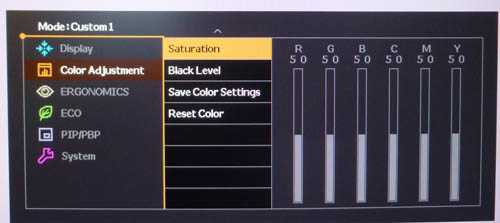
Further down this section are also the options
shown above. Once you've set what you want you need to use the "save color
settings" option to save them to either 'custom 1' or 'custom 2' presets.
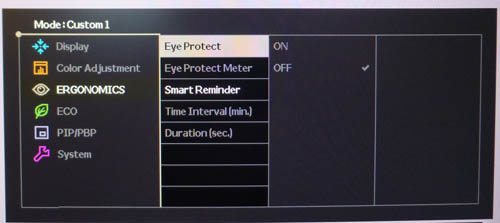
The third section is the 'ergonomics' section. Here you can access the Eye
Protect ambient light sensor and the Smart Reminder function. Useful for
office environments we felt.
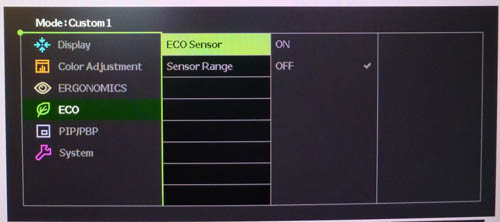
The ECO menu gives you access to the human motion sensor.
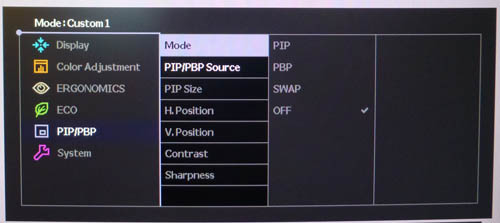
The PIP/PBP menu allows you to control the settings related to Picture In
Picture and Picture By Picture if you want to use them.
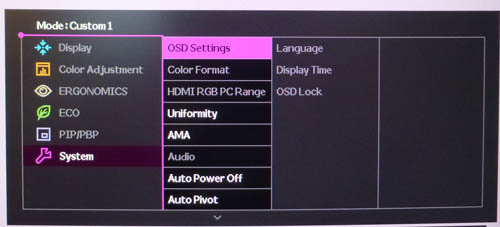
The 'system' menu allows you to control a few things related to the OSD itself
and the screen set up. Of interest here are the 'uniformity' feature (for
uniformity compensation) and the
AMA (overdrive) function. Again you can
scroll further down in this section to more options:
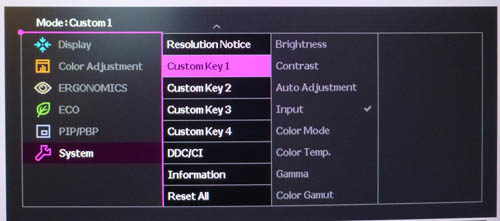
You can define what each of the quick access
buttons will do here which is useful.
All in all the menu offered a very wide range of
options and plenty to play with. Navigation was mostly ok, although sometimes
it did feel like you had to drill through several layers to get where you
wanted. The menu doesn't remember where you last were either, so it can be a
bit fiddly if you want to get back to your last setting quickly.

Power Consumption
In terms of power consumption the manufacturer
lists 74.6W typical usage during operation and 0.5W in standby/power save mode. We carried out our normal tests to
establish its power consumption ourselves.
|
 |
|
State and Brightness
Setting |
Manufacturer Spec (W) |
Measured Power Usage
(W) |
|
Factory Default (75%) |
74.6 |
40.3 |
|
Calibrated (4%) |
- |
24.1 |
|
Maximum Brightness (100%) |
- |
45.2 |
|
Minimum Brightness (0%) |
- |
23.5 |
|
Standby |
0.5 |
0.5 |
|
We tested this ourselves and found that out of the
box the screen used 40.3W at the default 75% brightness setting. At maximum
brightness the screen used 45.2W of power. Once calibrated the screen reached
24.1W consumption, and in standby it used only 0.5W. We have plotted these
results below compared with other screens we have tested:


Panel and Backlighting
|
Panel Manufacturer |
LG.Display |
Colour Palette |
1.07 billion from 4.4 trillion |
|
Panel Technology |
AH-IPS |
Colour Depth |
8-bit + FRC panel
14-bit 3D LUT |
|
Panel Module |
LM240WU9 |
Colour space |
Wide gamut |
|
Backlighting Type |
GB-r-LED |
Colour space coverage (%) |
100% sRGB, 104% NTSC, 99.3%
Adobe RGB |
Panel Part and Colour Depth
The BenQ PG2401PT utilises an
LG.Display LM240WU9 AH-IPS panel which is capable of producing 1.07
billion colours from a palette of 4.4 trillion. This is achieved with an 8-bit colour depth
panel and an additional
Frame Rate Control (FRC) stage (8-bit + FRC) as opposed to a true 10-bit
panel. The screen features a 14-bit 3D LUT which provides the 4.4 trillion
colour palette and can help improve grey scales and gradients.
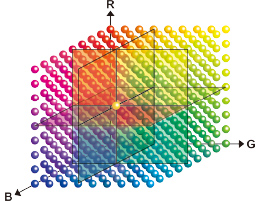
The 8-bit+FRC panel is a measure commonly taken on modern IPS panels, and the FRC
algorithm is very well implemented to the point that you'd be very hard pressed
to tell any difference in practice compared with a true 10-bit panel.
You need to take into account whether the 10-bit
colour depth this is practically useable for you and whether you're ever going
to truly use that colour depth. You need to have a full 10-bit end to end
workflow to take advantage of it which is still quite expensive to achieve and
rare in the market, certainly for your average user. This includes relevant
applications and graphics cards as well, so to many people this 10-bit support
might be irrelevant. Given the PG2401PT's position as a professional grade,
high-end screen, it's pleasing to see the support included.
The panel is
confirmed when accessing the factory menu:
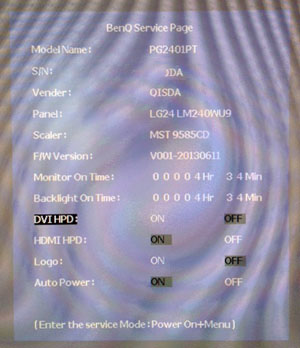
Screen
Coating
The
screen coating on the PG2401PT is much like that featured on other recent
IPS screens which has been a positive
change. It is a normal anti-glare (AG) offering as opposed to any kind of glossy
coating. However, this is contrary to a lot of other older IPS based screens
which usually feature a grainy and aggressive solution. Instead it is a light AG
coating which retains its anti-glare properties to avoid unwanted reflections,
but does not produce an overly grainy or dirty image. It's not a full
semi-glossy appearance like some screens but it is nice and light. There is no
sign of any cross-hatching type issues from the panel either.
Backlight Type and Colour Gamut
Like the Dell U2413 screen (which uses the same
panel as the BenQ), a new type of backlight has been used with LG.Display's
latest generation of IPS panel. They wanted to be able to offer the benefits of
LED backlighting (lower power consumption, lower heat output, thinner profile)
but deliver a wide colour gamut support for colour critical work and the
professional users. To achieve this, they have moved to the new GB-r-LED
backlight system.
The common White-LED (W-LED)
backlight systems, despite their name, do not actually use White LED's, but
rather they emit a blue light which passes through a yellow phosphor to give a
more neutral white and provide the red and green components of the image. With
the new GB-r-LED backlights, rather than using this blue diode + yellow
phosphor, the backlights combine green and blue diodes with a red phosphor. With
this new type of LED backlight the screen
covers 104% of the NTSC reference, 99% of the Adobe RGB reference and 100% (and
beyond) of the sRGB space. The screen is of course classified as a wide gamut
display so you need to consider whether this is something you want or need for
your uses.
For those who don't want to work with wide gamut
content or contend with complications around colour management or oversaturated
colours, an sRGB emulation preset mode is also provided thankfully.
Backlight
Dimming and Flicker
We tested the screen to establish the methods used
to control backlight dimming. Our in depth article talks in more details about a
common method used for this which is called
Pulse Width Modulation (PWM). This in itself gives cause for concern to some
users who have experienced eye strain, headaches and other symptoms as a result
of the flickering backlight caused by this technology. We use a photosensor +
oscilloscope system to measure backlight dimming control
with a high level of accuracy and ease. These tests allow us to establish
1) Whether PWM is being used to control the
backlight
2) The frequency and other characteristics at which this operates, if it is used
3) Whether a flicker may be introduced or potentially noticeable at certain
settings
If PWM is used for backlight dimming, the higher
the frequency, the less likely you are to see artefacts and flicker. The duty
cycle (the time for which the backlight is on) is also important and the shorter
the duty cycle, the more potential there is that you may see flicker. The other
factor which can influence flicker is the amplitude of the PWM, measuring the
difference in brightness output between the 'on' and 'off' states. Please
remember that not every user would notice a flicker from a backlight using PWM,
but it is something to be wary of. It is also a hard thing to quantify as it is
very subjective when talking about whether a user may or may not experience the
side effects.
100%

60%
40%
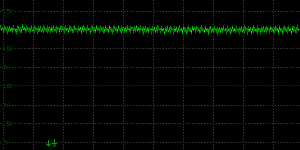
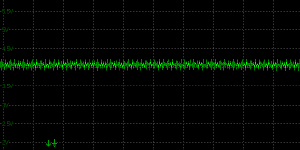
0%
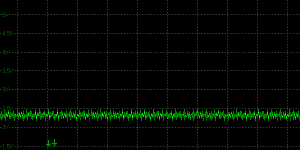
Above scale = 1
horizontal grid = 1ms
0% Zoomed in
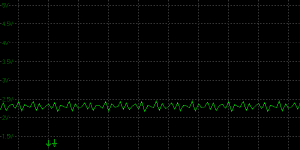
Above scale = 1
horizontal grid = 0.25ms
At 100% brightness there is a constant voltage
applied to the backlight and no flicker is introduced. As you start to lower the
brightness control a very high frequency oscillation is introduced which applies
all the way from 99 to 0% adjustment. This isn't a normal "full" PWM oscillation
and the amplitude (difference between the 'on' and 'off' states) is very low.
The backlight is not being cycled off in the normal PWM-style. We have provided
a smaller scale view at 0% brightness above as well. From this we can calculate
that the screen is using a very high oscillation frequency of 16,500Hz. This
shouldn't present any real problems to most users, although the screen isn't
fully flicker free.
|
Pulse Width
Modulation Used |
Yes |
|
Cycling
Frequency |
16,500Hz |
|
Possible
Flicker at |
|
|
100% Brightness |
No |
|
50% Brightness |
Yes |
|
0% Brightness |
Yes |
We noticed another slightly odd behaviour during
these measurements where every now and again there seemed to be a slightly
larger oscillation. This didn't seem to be within any pattern, but
occasionally the brightness of the backlight would drop slightly further than
normal (not visible to the naked eye).
40%
0%
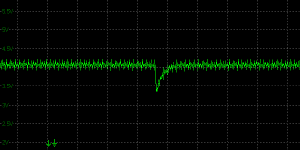
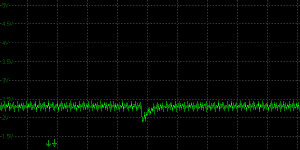
Above scale = 1
horizontal grid = 1ms
The above examples show this occasional random
drop in the brightness output.
For an up to date list of all flicker-free (PWM free) monitors please see our
Flicker Free Monitor Database.

Contrast
Stability and Brightness
We wanted to see how much variance there was in
the screens contrast as we adjusted the monitor setting for brightness.
In theory, brightness and contrast are two independent parameters, and good
contrast is a requirement regardless of the brightness adjustment.
Unfortunately, such is not always the case in practice. We recorded the
screens luminance and black depth at various OSD brightness settings, and
calculated the contrast ratio from there. Graphics card settings were left at
default with no ICC profile or calibration active. Tests were made using an
X-rite i1 Display Pro colorimeter. It should be noted that we used the
BasICColor calibration software here to record these, and so luminance at
default settings may vary a little from the LaCie Blue Eye Pro report.
We left
the screen at default settings apart from turning the uniformity compensation
feature off. That impacts luminance and contrast ratio which we will look at
later on in
the review.
|
OSD
Brightness |
Luminance
(cd/m2) |
Black
Point (cd/m2) |
Contrast
Ratio
( x:1) |
|
100 |
313.91 |
0.41 |
766 |
|
90 |
303.82 |
0.38 |
800 |
|
80 |
281.09 |
0.36 |
781 |
|
70 |
260.12 |
0.33 |
788 |
|
60 |
236.99 |
0.30 |
790 |
|
50 |
215.84 |
0.27 |
799 |
|
40 |
194.66 |
0.25 |
779 |
|
30 |
173.54 |
0.22 |
789 |
|
20 |
151.35 |
0.19 |
797 |
|
10 |
130.12 |
0.17 |
765 |
|
0 |
108.89 |
0.14 |
778 |
|
Total Luminance Adjustment Range
(cd/m2) |
205.02 |
Brightness OSD setting controls backlight? |
 |
|
Total Black Point
Adjustment Range (cd/m2) |
0.27 |
|
Average Static Contrast Ratio |
785:1 |
PWM Free? |
 |
|
Recommended OSD setting for 120 cd/m2 |
6 |
The brightness control gave us a reasonable range
of adjustment overall, although it was a little lacking at the lower end. At the
top end the maximum luminance reached 314
cd/m2 which was
a bit lower than the specified maximum brightness of 350 cd/m2
by the manufacturer. There was a 205 cd/m2 adjustment range in total,
and so at the minimum setting you could reach down to a luminance of 109 cd/m2.
This should be more than adequate for general lighting conditions but may be too
high for those wanting to work in darkened room conditions with low ambient
light. A setting of ~6 in the OSD menu should return you a
luminance of around 120 cd/m2 at default settings.
It was possible to
achieve a lower minimum luminance if you turn the uniformity compensation
feature on, and the minimum we recorded was 63.25 cd/m2. However this
severely impacted contrast ratio, reducing it to 452:1. A partial solution
though if you want to use the screen in lower ambient lighting conditions. On a
side note, the
uniformity
compensation feature seems to work very well, so it may well be something
users want to make use of.

We have plotted the
luminance trend on the graph above. The screen behaves as it should in this
regard, with a reduction in the luminance output of the screen controlled by the
reduction in the OSD brightness setting. This was pretty much a linear
relationship as you can see from the shape of the graph. It should be noted also
that the brightness regulation is controlled by a high frequency (16,500Hz)
Pulse Width Modulation (PWM), although not with a full amplitude which you
would see on most PWM screens. It can't be classified as flicker-free, but the
frequency and low amplitude should hopefully mean it is not problematic to most
users.

The average contrast ratio of
the screen was 785:1 and it remained stable across the brightness
adjustment range as shown above. It was moderate for an IPS panel and not as
high as we've seen from other modern panels of this type.

Testing
Methodology
An
important thing to consider for most users is how a screen will perform out of
the box and with some basic manual adjustments. Since most users won't have
access to hardware colorimeter tools, it is important to understand how the
screen is going to perform in terms of colour accuracy for the average user.
I
restored my graphics card to default settings and disabled any previously active
ICC profiles and gamma corrections. The screen was tested at default factory settings using the DVI interface, and analysed using
an
X-rite i1
Pro Spectrophotometer (not to be confused with the i1 Display Pro
colorimeter) combined with
LaCie's Blue Eye Pro software suite. An X-rite i1 Display Pro colorimeter was
also used to verify the black point and contrast ratio since the i1 Pro
spectrophotometer is less
reliable at the darker end.
Targets for these tests are as follows:
-
CIE Diagram - validates the colour space
covered by the monitors backlighting in a 2D view, with the black triangle representing the
displays gamut, and other reference colour spaces shown for comparison
-
Gamma - we aim for 2.2 which is the default
for computer monitors
-
Colour temperature / white point - we aim
for 6500k which is the temperature of daylight
-
Luminance - we aim for 120
cd/m2, which is
the recommended luminance for LCD monitors in normal lighting conditions
-
Black depth - we aim
for as low as possible to maximise shadow detail and to offer us the best
contrast ratio
-
Contrast ratio - we aim
for as high as possible. Any dynamic contrast ratio controls are turned off here
if present
-
dE average / maximum -
as low as possible.
If DeltaE >3, the color displayed is significantly different from the
theoretical one, meaning that the difference will be perceptible to the
viewer.
If DeltaE <2, LaCie considers the calibration a success; there remains a
slight difference, but it is barely undetectable.
If DeltaE < 1, the color fidelity is excellent.

Default Performance and
Setup
|
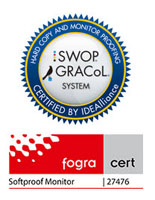 |
BenQ PG series monitors are tested against standard printing colour charts
and real printing house results to determine which aspects of colorations
prove to be the most challenging for graphic professionals. As defined by
these test results, the BenQ PG series specializes in colour reproduction
for tones with a Delta-E value lower than two (dE <2).
BenQ PG series monitors are Printing-Industry Color Certified (G7/Fogra)
according to international ISO standards that improve design and proofing
efficiency and lower total cost of ownership.
Each BenQ PG series display is subjected to a verification process on-site
upon production in order to test the performance of the monitor in terms of
Brightness uniformity, Delta-E and Gamma curve. These results are validated
against BenQ and industry colour standards—the results of the test are noted
on a calibration report, included with each individual PG series monitor. |
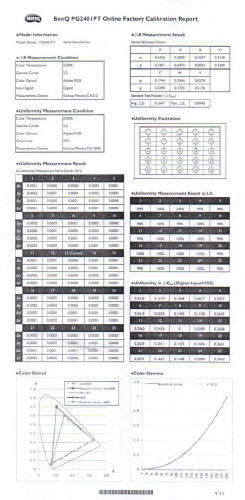
Above: calibration report
supplied. Click for larger version
The calibration report which came with our sample
is shown above for reference. It confirms the screen comes factory calibrated to
a 6500k white point and 2.2 gamma. dE should also be <2 and BenQ have also
carried out some uniformity correction measurements for that uniformity
compensation feature which we will test
later on
in the review. For now we can test the factory calibration at least.
Default settings of the screen were as follows:
|
Monitor OSD Option |
Default Settings |
|
Brightness |
75 |
|
Contrast |
50 |
|
Preset mode |
Standard |
|
RGB |
n/a |
|
Color Temp |
6500k |
|
Gamma |
2.2 |
|
Color Gamut |
Adobe RGB |

BenQ PG2401PT - Default Factory Settings, Adobe RGB gamut



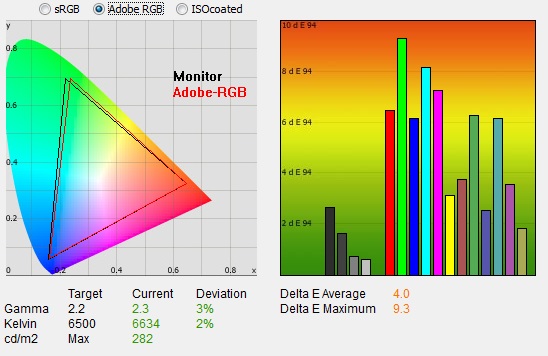
|
|
Default Settings,
Adobe RGB Gamut |
|
luminance (cd/m2) |
282 |
|
Black Point (cd/m2) |
0.36 |
|
Contrast Ratio |
780:1 |
The only thing we changed in the OSD initially was
turning the uniformity compensation feature off. Out of the box the screen was
very bright and colours felt vivid. You could tell the screen was wide gamut
straight away and greens in particular looked oversaturated. It comes out of the
box in the 'standard' preset mode, and with color gamut set to Adobe RGB. You
can change this to sRGB as well in the 'standard' mode, which we will test in a
moment. There are also defined 'Adobe RGB' and 'sRGB' preset modes available in
the OSD menu. The colour temperature and whites felt about right so we went ahead and measured
the default state with the i1 Pro.
The
CIE diagram on the left of the image confirms that the monitors colour gamut
(black triangle) matches the Adobe RGB colour space reasonably well, with some
over-coverage evident in some green shades and some under-coverage also. Default gamma was recorded at 2.3 average, leaving
it a little out with an 3% deviance from the target of 2.2. White point was
measured at 6634k leaving it a small 2% out from
our target of 6500k which was very pleasing. Note that we are using a
spectrophotometer to make these measurements which is not sensitive to the wide
gamut backlight as some colorimeter devices can be. When using a standard gamut
colorimeter not designed to work with modern backlighting units like W-LED,
WCG-CCFL and GB-r-LED there can be a typical deviance of 300 - 600k in the white
point measurement which is why some sources may refer to a different white point
in this test incorrectly.
Luminance was recorded at a very bright 282
cd/m2 which is
too high for prolonged general use, and needs to be turned down. The screen was set
at a default 75% brightness in the OSD menu but that is easy to change of course
to reach a more comfortable setting without impacting other aspects of the
performance. The black depth was 0.36 cd/m2 at this default
brightness setting, giving us a moderate IPS static contrast ratio of
780:1.
Colour accuracy measurements are based on a
comparison with sRGB so should be ignored here. Testing the screen with various
gradients showed smooth transitions with no sign of any banding thankfully.
There was some very slight gradation evident in darker tones as you will see
from most monitors but not something you'd see in normal use though at all. The
default setup was pretty good, although it was too bright. The factory
calibrated white point and gamma were only slightly off by our measurements. We
will be able to test the colour accuracy setup in the next section once we are
measuring the sRGB colour space. Incidentally, the actual 'Adobe RGB' preset
mode in the menu has exactly the same setup as the standard mode here, just with
the brightness set at 50% instead of 75%. The other results were identical.

We then switched the 'color gamut' setting to sRGB and tested the default setup
again
|
Monitor OSD Option |
Default Settings |
|
Brightness |
75 |
|
Contrast |
50 |
|
Preset mode |
Standard |
|
RGB |
n/a |
|
Color Temp |
6500k |
|
Gamma |
2.2 |
|
Color Gamut |
sRGB |

BenQ PG2401PT - Default Factory Settings, sRGB gamut
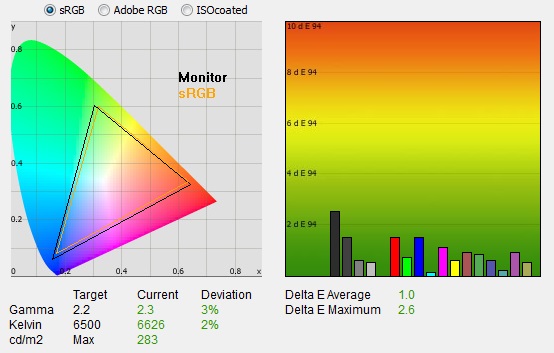
|
|
Default Settings,
sRGB gamut |
|
luminance (cd/m2) |
283 |
|
Black Point (cd/m2) |
0.36 |
|
Contrast Ratio |
775:1 |
The 'color gamut' setting was switched to sRGB now
which emulates the smaller standard gamut colour space nicely. The colour space
is now very close to the sRGB reference although it doesn't match exactly.
Default setup was very similar to before when we were in the 'Adobe RGB' gamut.
Gamma was still at 2.3 with a 3% deviance, and white point was 2% out at 6626k.
Luminance was still too high for comfortable use, and contrast ratio was
basically the same at 775:1. We can at least now use the dE measurements as they
are comparing against the sRGB reference. dE was on average very low at 1.0
which was excellent. This represented a very good factory calibration, with only
minor tweaks needed really to improve gamma and white point slightly.
Again there is a defined sRGB preset available in
the menu which performs identically to this 'standard' mode (set with sRGB
colour gamut). The only difference is it has a default brightness setting of 50%
instead of 75% in the standard preset.

Colour Temperatures
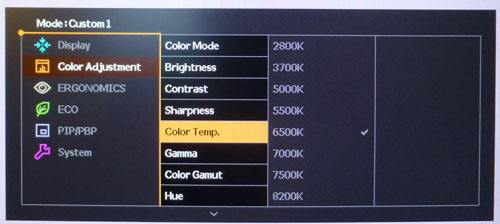
The PG2401PT features a range of colour
temperature
presets within the OSD 'color adjustment' menu as shown above. There are a wide
range of pre-defined colour temps available as well as a 'custom' and 'user
define' mode. We measured the screen
with the X-rite i1 Pro spectrophotometer in each of the preset modes to establish
their colour temperature / white point. All other settings were left at factory defaults and no
ICC profile was active, although we did turn off the uniformity compensation
feature. The results are recorded below:
|
Selected Preset Mode (k) |
Measured Colour Temperature (k) |
Deviance from target (k) |
Deviance |
|
2800 |
2898 |
98 |
3.5% |
|
3700 |
3776 |
76 |
2.1% |
|
5000 |
5121 |
121 |
2.4% |
|
5500 |
5639 |
139 |
2.5% |
|
6500 |
6677 |
177 |
2.7% |
|
7000 |
7242 |
242 |
3.5% |
|
7500 |
7777 |
277 |
3.7% |
|
8200 |
8527 |
327 |
4.0% |
|
9300 |
9725 |
425 |
4.6% |

Some of the colour temperature modes offered reasonable
levels of accuracy. Overall there was a maximum deviance from the target of
4.6%, and an average of 3.2% which wasn't too bad but not perfect. The warmer
settings were closer to their desired temp with a deviance of around 76 -
121k. As the setting got cooler, there was a larger temp difference ranging up
to 425k maximum at the coolest setting.

Software Calibration
The PG2401PT may well have a
decent factory setup but given the market for this screen I
expect many users will want to calibrate the screen personally to obtain even
higher levels of accuracy and allow profiling and matching between different
devices. Remember, you need to ensure you have a calibration device capable of measuring
and reading the spectra from the GB-r-LED backlight unit properly. Many older
colorimeter devices are designed to work with standard gamut CCFL units only and
so they can often have difficulty reading LED (and wide gamut CCFL) units
properly. A spectrophotometer does not have this problem and there are also some
decent modern colorimeters like the X-rite i1 Display Pro which should be able
to read LED without issue. While you can use other devices and various software
packages to complete software profiling of the screen, you may come across
issues if the device is not designed to work with an LED backlight unit.
The PG2401PT also offers
hardware calibration which can give you very high levels of accuracy and
control over the monitors hardware LUT itself. We will look at that in a moment,
but we also wanted to carry out the usual software level "calibrations"
(profiling) at a graphics card level. We used the
X-rite i1 Pro spectrophotometer combined with the LaCie Blue Eye Pro
software package to achieve these results and reports. An X-rite i1 Display Pro was used to validate the black depth and contrast
ratios due to lower end limitations of the i1 Pro device.
|
Monitor OSD Option |
Calibrated Settings |
|
Brightness |
4 |
|
Contrast |
50 |
|
Preset mode |
Custom 1 |
|
Color Temp |
6500k |
|
Gamma |
2.2 |
|
Color Gamut |
Adobe RGB |
|
Uniformity Compensation |
Off |

BenQ PG2401PT - Software Calibrated Settings, Adobe RGB
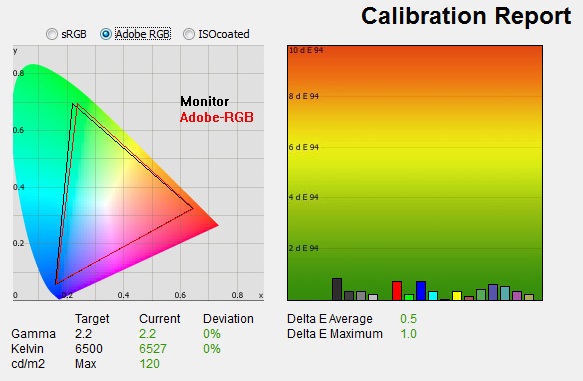
|
|
Calibrated Settings,
Adobe RGB |
|
luminance (cd/m2) |
120 |
|
Black Point (cd/m2) |
0.17 |
|
Contrast Ratio |
717:1 |
We first of all reverted to the 'custom 1' preset
mode in the OSD menu to allow us to set up a preset specifically to our
requirements. We left the color temp setting at 6500k and gamma at 2.2 as they
had been very close to their targets out of the box, and the software profiling
would make the minor corrections needed. We set 'custom 1' mode to use the Adobe
RGB gamut, and we will set 'custom 2' to sRGB in a moment to calibrate in that
colour space. Once you've set your OSD settings how you want, you have to go
into the option to save the colour settings, at which point it saves them to
either 'custom 1' or 'custom 2'. This way we can set up two software calibrated
modes so we can quickly and easily switch between them if we want, remembering
we will also need to switch the active ICC profile when we do.
We left the LaCie software to calibrate to "max"
brightness which would just retain the luminance of whatever brightness we'd set
the screen to, and would not in any way try and alter the luminance at the
graphics card level, which can reduce contrast ratio. These adjustments before
profiling the screen would help preserve tonal values and limit banding issues.
After this we let the software carry out the LUT adjustments and create an
ICC profile.

Average gamma had been corrected to 2.2 average according to the initial test, correcting
the default 3% deviance we'd
found out of the box which was good. The white point was also
corrected to 6527k,
correcting the minor 2% deviance we'd seen out of the box. Luminance had also been
improved thanks to the adjustment to the brightness control and was now being
measured at 120
cd/m2. We did
have to lower the brightness control all the way down to 4%, so there is minimal
adjustment left if you want to work with a darker screen.
This left us a black depth of 0.17 cd/m2 and a moderate IPS
static contrast ratio of 717:1. If you turn on the uniformity compensation
feature you can achieve a lower luminance, but the contrast ratio is negatively
impacted.
Testing the screen with various colour gradients
showed smooth transitions. There was some slight gradation in darker tones
but no banding was introduced which can often happen where adjustments are made to the
graphics card LUT from the profilation of the screen.
You can use our settings and
try our calibrated ICC profile if you wish, which are available in
our ICC profile database. Keep in mind that results will vary from one
screen to another and from one computer / graphics card to another.

|
Monitor OSD Option |
Calibrated Settings |
|
Brightness |
4 |
|
Contrast |
50 |
|
Preset mode |
Custom 2 |
|
Color Temp |
6500k |
|
Gamma |
2.2 |
|
Color Gamut |
sRGB |
|
Uniformity Compensation |
Off |

BenQ PG2401PT - Software Calibrated Settings, sRGB
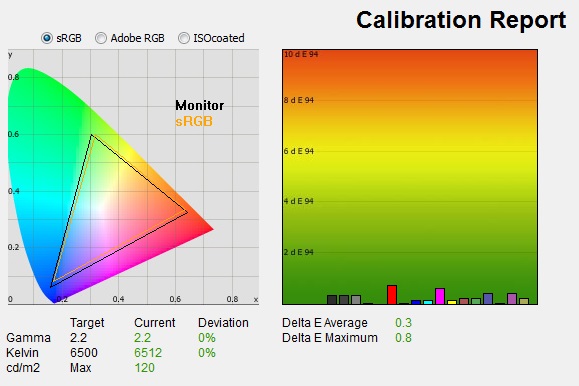
|
|
Calibrated Settings,
sRGB |
|
luminance (cd/m2) |
120 |
|
Black Point (cd/m2) |
0.17 |
|
Contrast Ratio |
709:1 |
We also carried out a software calibrated based on
the sRGB colour space, with the settings listed in the table above which we
saved to 'custom 2' mode. The calibration was again a success. We had corrected
the default 3% gamma and 2% white point deviance out of the box nicely. Colour
accuracy was also improved a little, although the default factory setup was very
good in this area. It had improved from dE average of 1.0 (out of the box) to
0.3 now. Colour gradients remained free from banding and contrast ratio was
comparable with before.

Hardware
Calibration
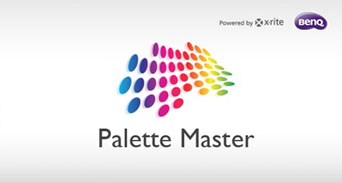

One thing which separates this screen from many
mainstream monitors is the support for hardware calibration. Users can
program the monitors 14-bit 3D Look Up Table (LUT) if they have the appropriate
software and hardware to achieve higher levels of accuracy, something which
professional users require and one of the reasons why pro-grade screens from NEC
and Eizo have always been popular in such markets. The provided "Palette Master"
software is co-produced by BenQ and X-rite and is similar in fact to the Dell
software we tested recently for the
UP3214Q display. There are a few differences, and a couple of extra features
in fact which we will look at here. There is a useful guide/walkthrough of the
software on BenQ's website
here as well.
You
will require a compatible calibration tool to work with this software and allow
hardware calibration. The only devices supported by the software at this time
(again, like the new Dell software) are the X-rite i1 Display Pro, i1 Pro and i1
Pro 2 devices. We'd like to see support for other devices like the ColorMunki,
but support for the current devices is pretty good anyway.
Palette Master
Software
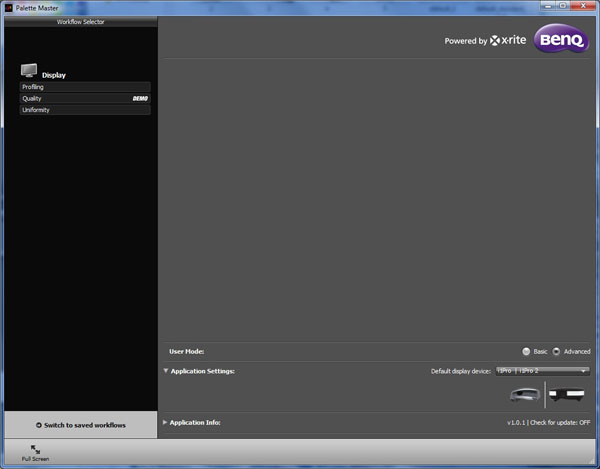
The software will be fairly familiar to anyone
who's used X-rites i1 Profiler package, and looks pretty similar overall. There
are options on the front screen to choose your calibration device. On the left
hand side are the three options available for profiling (the actual calibration
process), quality (a reporting feature) and uniformity (measuring screen
uniformity).
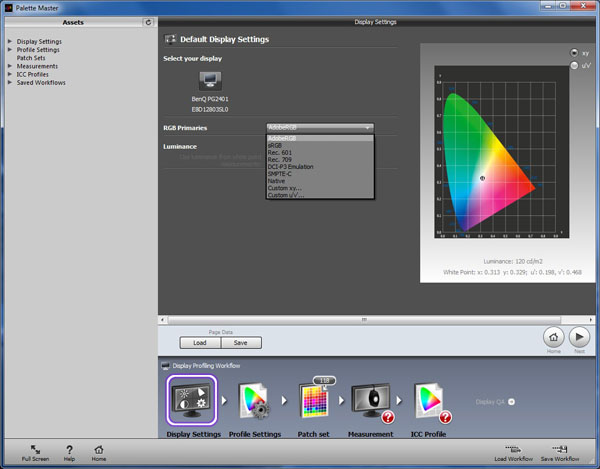
Entering the profiling section allows you to
select the desired colour gamut you want to calibrate to, as well as the target
luminance. Each of the pre-defined colour spaces have a preset gamma and white
point relevant to their colour space, but you can also use the custom options if
you want more control yourself.
Once selected you can just press 'next' to go
through the other options including defining the ICC profile settings, sample
set for measurements and then calibrating your device if need be before the
process starts. We won't go into them in detail as you can see the guide linked
on BenQ's site if you want more screenshots. The actual calibration process is
automated but takes a long time to complete, even with smaller sample sets (less
accurate). You have two modes you can calibrate which are saved as 'calibration
1' or 'calibration 2' in the preset mode menu. You can also choose within the
calibration options whether the uniformity compensation feature is turned on or
off, as once the calibration has completed you can't change much from within the
OSD manually (including that feature).
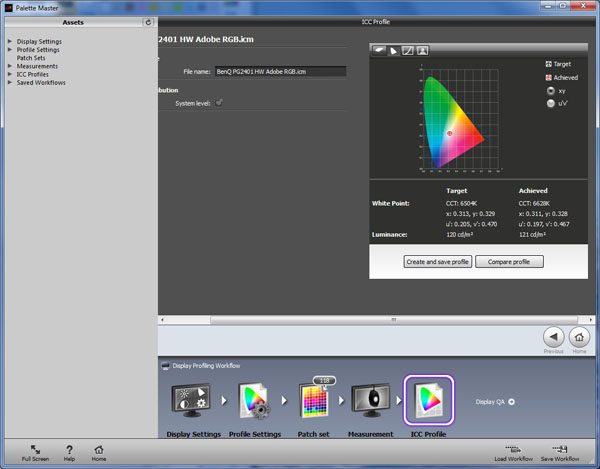
Once complete you are asked to save the ICC profile and presented with some
brief results around achieved white point and luminance. Pressing the 'Display
QA' arrow at the bottom takes you to some validation options as well.
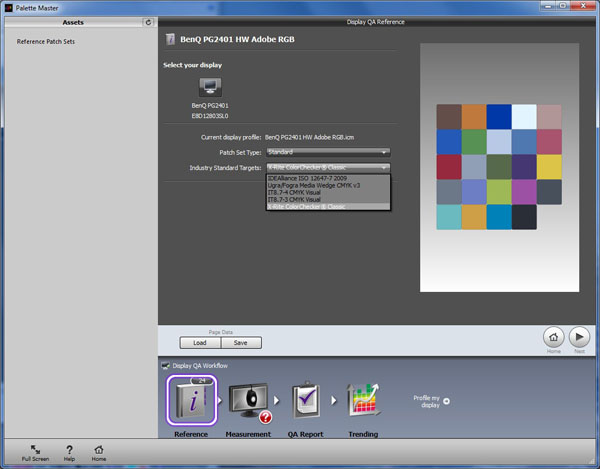
There are various different patch sets and
validation options to select which will take various measurements and confirm
the success of your calibration. Nice to see this reporting feature included. We
will carry out some hardware calibrations in a moment and also validate the
results using our normal LaCie Blue Eye Pro report feature for easy comparison.
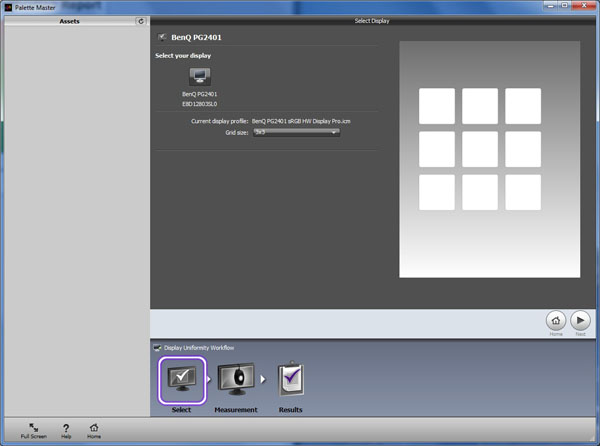
The 'uniformity' option is something new to this
software and not something included in Dell's calibration package. It allows you
to quickly and easily measure a grid on your screen and then confirms your
uniformity of whites, greys and black.
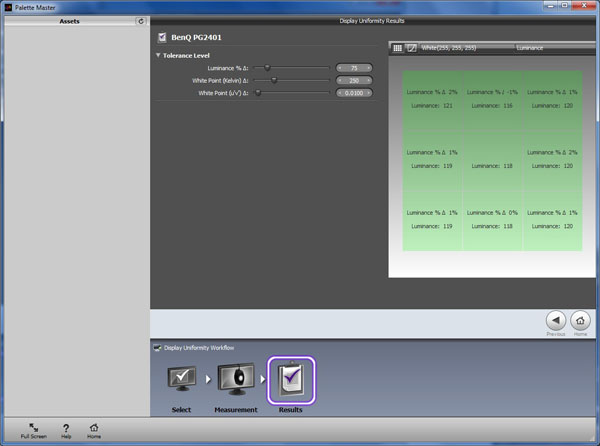
The results are shown like the example above and
you can also switch to a graph type mode if you want:
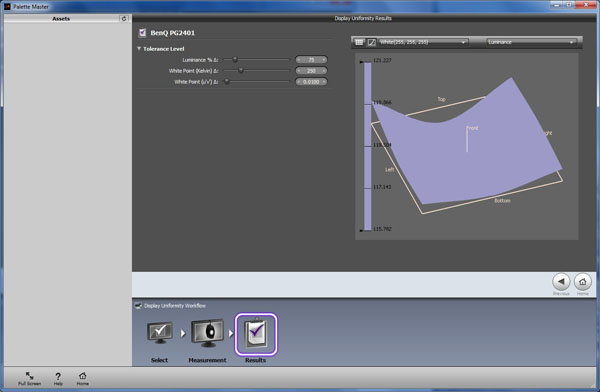
This is a useful feature and handy to test your
specific units uniformity. You may want to experiment with the
uniformity
compensation feature as well to see whether they helps for your particular
needs.
Hardware Calibration Results
We carried out the hardware calibration first of
all with the i1 Pro device in the Adobe RGB gamut option. We then used the LaCie
report function to validate the results. As with our other calibrations earlier,
uniformity compensation was left off.

BenQ PG2401PT - Hardware Calibrated Settings, Adobe RGB
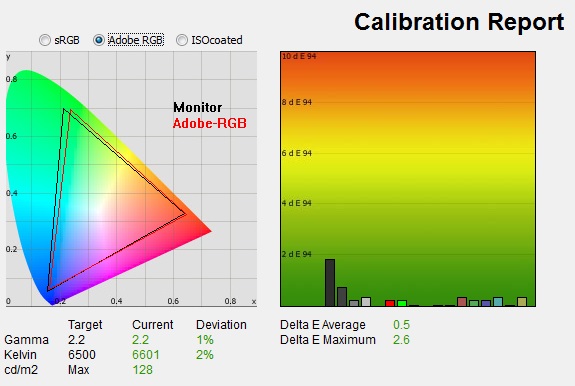
|
|
HW Calibrated Settings,
Adobe RGB |
|
luminance (cd/m2) |
128 |
|
Black Point (cd/m2) |
0.18 |
|
Contrast Ratio |
710:1 |
The hardware calibration was on the whole pretty
good. The 3% default gamma deviance we'd seen out of the box had been corrected
to within 1% now, although the white point remained 2% out from the target
according to these tests. Luminance was actually a bit higher than the specified
120
cd/m2,
resulting in a measurement of 128 cd/m2 instead. We had seen
something similar from the Dell calibration software as well, and you may need
to specify a lower luminance in the hardware calibration process to achieve a
resulting luminance nearer to 120 cd/m2. Colour gradients were smooth
with no sign of banding.
One thing to note is that
once you've completed the hardware calibration, you cannot manually change the
brightness in the OSD menu. You'd have to carry out a completely new calibration
again to change the luminance which is a real pain, especially if you want to
work with your calibrated modes in different lighting conditions. Given the HW
calibration takes so long to complete, it's not practical to have to go and redo
it all again just to change the brightness of the screen. It was also a pain not
to be able to turn things like uniformity compensation on from within the OSD
menu. Again you have to set that at the beginning of the HW calibration so you'd
have to redo it all again if you decide you want to turn that on.

BenQ PG2401PT - Hardware Calibrated Settings, sRGB
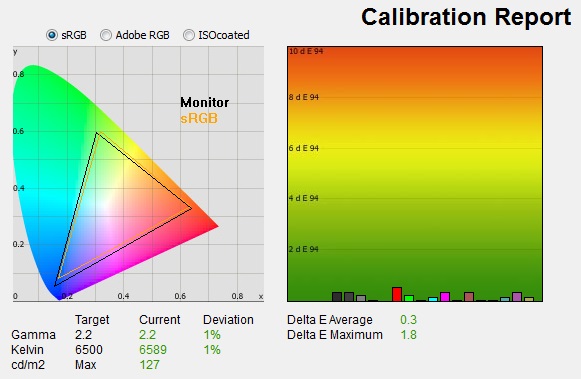
|
|
HW Calibrated Settings,
sRGB |
|
luminance (cd/m2) |
127 |
|
Black Point (cd/m2) |
0.18 |
|
Contrast Ratio |
711:1 |
The default sRGB mode had a very reliable
factory setup
anyway but this HW calibration did help improve things nicely. The 3% gamma
deviance out of the box was corrected within 1%, and the 2% white point deviance
was now a bit closer with only a 1% error. Again luminance was a bit higher than
specified in the process. Colour gradients were again very smooth, and colour
accuracy was excellent with a dE average of 0.3 now, down from 1.0 out of the
box (which was excellent anyway). We saved this as 'calibration 2' in the preset
menu, and it was good to be able to have one mode set up as Adobe RGB and
another as sRGB. It's just a shame you need to repeat the HW calibration process
if you ever want to alter brightness or turn uniformity compensation on/off.

Calibration
Performance Comparisons

The comparisons made in this section try to give
you a better view of how each screen performs, particularly out of the box which
is what is going to matter to most consumers. When comparing the default factory
settings for each monitor it is important to take into account several
measurement areas - gamma, white point and colour accuracy. There's no point
having a low dE colour accuracy figure if the gamma curve is way off for
instance. A good factory calibration requires all 3 to be well set up. We have
deliberately not included luminance in this comparison since this is normally
far too high by default on every screen. However, that is very easily controlled
through the brightness setting (on most screens) and should not impact the other
areas being measured anyway. It is easy enough to obtain a suitable luminance
for your working conditions and individual preferences, but a reliable factory
setup in gamma, white point and colour accuracy is important and not as easy to
change accurately without a calibration tool.
From these comparisons we can also compare the
calibrated colour accuracy, black depth and contrast ratio. After a calibration
the gamma, white point and luminance should all be at their desired targets.

Default setup of the screen was very good overall,
and should be fine for most users even without access to a calibration device. There was only a minor deviance in the
desired gamma, with a 3% error and a minor 2% error in the white point as well.
Colour accuracy was excellent in the sRGB mode (where we could use the dE
measurements compared with the sRGB colour space), with an average dE of 1.0.


The panel was weaker when it came to black depth
and contrast ratio unfortunately. At 711:1 after calibration (software
calibration in the sRGB mode) it was only moderate for an IPS panel. We had seen
some IPS panels reach up to over 1000:1, like the Dell P2414H (1010:1) for
instance. The PG2401PT was comparable, but slightly behind the Dell U2413
(783:1) which uses the same IPS panel. Other panel technologies like the AMVA
based BenQ GW2450HM and GW2760HS can reach much higher contrast ratios than any
IPS panel at the moment, around 2000 - 2500:1 in fact. The MVA panel in the Eizo
FG2421 was even better at 4845:1.

Viewing Angles
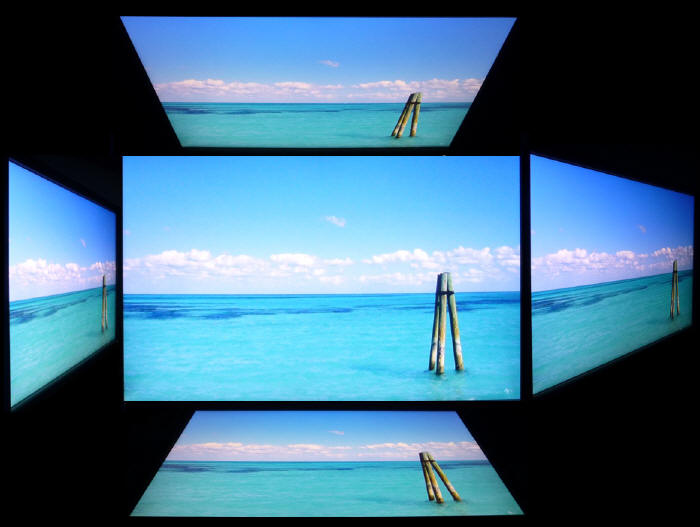
Above: Viewing
angles shown from front and side, and from above and below. Click for
larger image
Viewing angles of the PG2401PT were very good as
you would expect from an IPS based panel. Horizontally there was very little
colour tone shift until wide angles past about 45°. Contrast shifts were
slightly more noticeable in the vertical field but overall they were very good.
The screen offered the wide viewing angles of IPS technology and was free from
the very restrictive fields of view of TN Film panels, especially in the
vertical plane. It was also free of the off-centre contrast shift you see from
VA panels and a lot of the quite obvious gamma and colour tone shift you see
from some of the modern AMVA and PVA offerings. All as expected really from a
modern IPS panel.
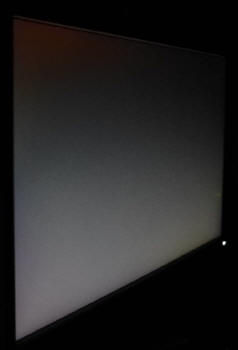
Above: View of an
all black screen from the side. Click for larger version
On a black image there is a characteristic and
fairly typical IPS white glow, but in normal working conditions this shouldn't
present much problem. The above image was taken in a darkened room to
demonstrate the white wide angle glow when viewing a black screen. There is no
A-TW polarizer on this panel which is rarely used now in the market but was
implemented on some older screens to improve the off centre black viewing.
If you are viewing dark content from a close
position to the screen you can sometimes see this pale glow on parts of the
screen towards the sides and corners because of your proximity to the screen and
your line of sight. The edges of the screen are at an angle from your line of
sight which means you pick up this white glow to a smaller degree. This is often
referred to as "IPS glow". This disappears as you move backwards away from the
screen where the line of sight does not result in a wide angle view of parts of
the screen and you can see the screen largely from head on. This glow should not
be mistaken for backlight bleeding which would not disappear as you changed your
line of sight or angle of viewing.

Panel Uniformity
We wanted to test
here how uniform the brightness was across the screen, as well as identify any
leakage from the backlight in dark lighting conditions. Measurements of the
luminance were taken at 35 points across the panel on a pure
white background. The measurements were taken using BasICColor's calibration
software package, combined with an X-rite i1 Display Pro
colorimeter with a central point on the screen calibrated to 120 cd/m2. The below uniformity diagram shows the difference, as a percentage,
between the measurement recorded at each point on the screen, as compared with the
central reference point.
It is worth
noting that panel uniformity can vary from one screen to another, and can depend
on manufacturing lines, screen transport and other local factors. This is only a
guide of the uniformity of the sample screen we have for review.
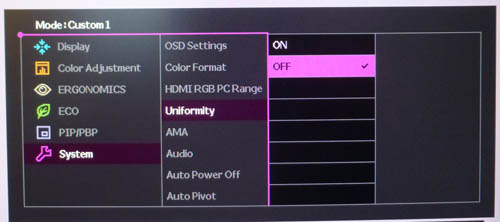
The PG2401PT
features a uniformity compensation feature designed to help improve the
uniformity of the screen, and something only really available on high end
screens like this. It is available in the 'system' section of the OSD menu as
shown above with a setting for on and off available.
First of all we
tested the screen with the feature off.

Uniformity of Luminance
Uniformity Compensation = Off
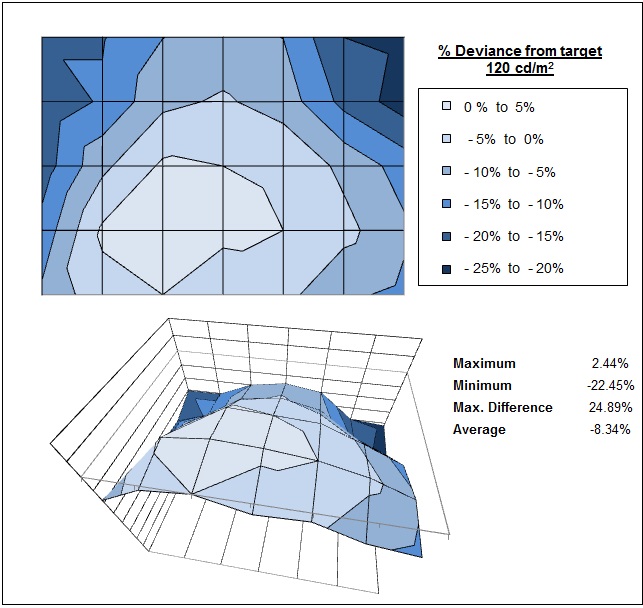
The luminance uniformity of the screen was
mostly good, although the top corners of the screen were quite a bit darker
than the lower half of the screen. In the top corners the luminance dropped
by a maximum of -22.45%, down to around 98
cd/m2.
The lower and central regions remained closer to the calibrated central 120
cd/m2 point. Around 63% of the screen was within a 10% deviance
from the central point. Not brilliant considering the screen is aimed at
professional uses. We will see whether the uniformity compensation feature
helps at all:

Uniformity of Luminance
Uniformity Compensation = On
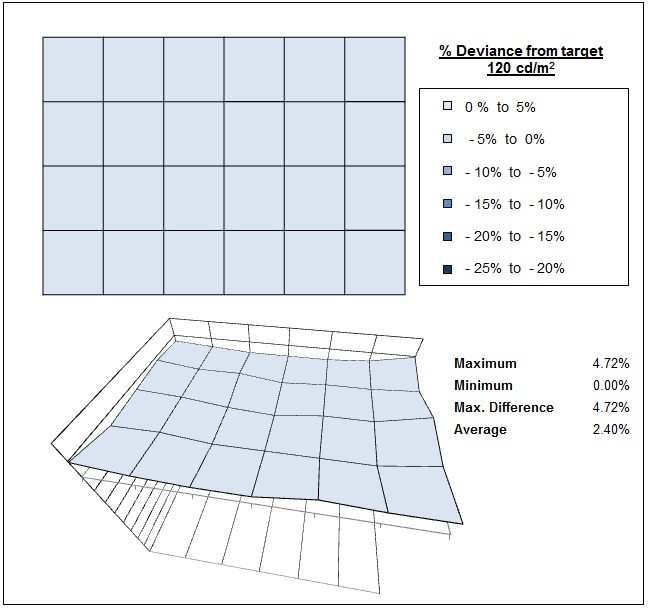
The uniformity compensation feature made a
huge difference. The whole screen was now within 5% deviance from the
centrally calibrated 120
cd/m2
and it did a great job of correcting the darker regions in the upper
corners. This feature had been very well set up it seems and it was
great to see it could correct the uniformity so well if you needed. There is
a draw back to using this feature unfortunately in that it reduced the
static contrast ratio quite a bit, from around 785:1 (set off, before
calibration) to 452:1 (turned on). That is common to other screens with
uniformity correction though including NEC and Eizo offerings.
The feature does have the added benefit
also of
making the screen darker, helping to overcome some of the issues with the
somewhat limited
minimum brightness setting we'd seen before. This means you can achieve
a lower luminance if you need to as well for darker working conditions. A
setting of 46 brightness was actually needed to reach ~ 120 cd/m2
now when uniformity compensation was turned on, instead of 4 which we'd set
it at before. The other good thing about this feature is that it can be used
regardless of your brightness and colour gamut setting in the OSD, so you
aren't locked to only using it in only certain presets or at certain
pre-defined brightness/contrast levels like you are on the recent Dell
screens. If you want to use the feature for hardware calibrated modes you
need to specify it as an option at the beginning of the calibration
software, as you cannot then turn it on or off within the OSD once in those
modes.

Backlight Leakage
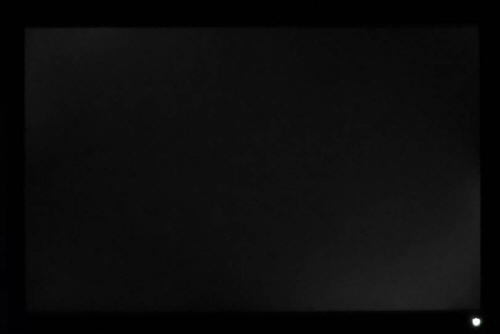
Above: All black screen in a darkened room. Click for larger version
As usual we also tested the screen with an all
black image and in a darkened room. A camera was used to capture the result.
Three was some slight clouding in the upper left hand corner and some wider
clouding in the bottom right corner of the screen. It wasn't something you can
see during normal day to day use, but perhaps could prove problematic if viewing
a lot of dark content in low ambient lighting.

General and Office Applications
The 1920 x 1200 resolution and 24" screen size
give a nice decent area in which to work and the vertical resolution is a little
more than the wide range of 16:9 aspect 23 - 24" models (1920 x 1080) out there
in the market. A lot of people prefer this extra vertical area and it is useful
for office applications we think. You may want to consider the fact that high
resolution 27" 2560 x 1440 models are becoming increasingly available and so the
difference in desktop size is certainly noticeable coming from a 27" screen like
that. Nevertheless, the 24" 1920 x 1200 resolution should be adequate for many
users. The screen offered a comfortable 0.27mm pixel pitch which delivered easy
to read text at a nice size. The resolution is big enough for side by side split
screen working as well in many cases.
The light AG coating of the new AH-IPS panel is
certainly welcome, and a very positive change from the older grainy and 'dirty'
appearance of older IPS AG coatings. The
wide viewing
angles provided by the IPS panel technology on both horizontal and vertical
planes, helps minimize on-screen colour shift when viewed from different angles.
The
default factory setup of the screen was good in terms of gamma, white point and
the balance of colours, with only minor errors from the factory calibration.
This means even those without a hardware calibration device can achieve reliable
results from this screen. Of course for maximum levels of accuracy and control
users will want a compatible calibration device to hardware calibrate the
screen. For this, the provided BenQ/X-rite software was easy to use and has a
decent range of options and features, including a useful reporting function and
even uniformity measurement system. The only issue with HW calibration is that
once done, you can't change basic settings like the OSD brightness, or turn
uniformity compensation on and off. Having to carry out the whole, very long,
process again is not ideal when you want to make a simple change like this. It's
understandable to lock other aspects of the menu, but basic control over the
brightness would have been useful. Regardless, the actual HW calibration
produced reliable results which was pleasing.
The contrast
ratio of the PG2401PT was moderate out of the box for an IPS panel at ~780:1 which was
ok but not great.
After calibration the contrast ratio was a little lower at around 710:1. The
size of the
brightness
adjustment range of the screen was very good, with the ability to offer a
luminance between 314 and 109 cd/m2. However, it was lacking at the
lower end with a fairly high minimum luminance. Those wanting to work in darker
lighting conditions may find this limiting. Turning the uniformity compensation
feature on allows you to reach a lower luminance, down to around 63 cd/m2
if needed, as long as you're prepared to take a hit to your contrast ratio. A
setting of ~6 in the OSD brightness
control should return you a luminance close to 120 cd/m2 when
uniformity compensation is turned off. While we're on the topic of the
uniformity compensation, this
worked very
well indeed and provided a reliable and stable uniformity for those who need
it. One issue which may affect some users is that the brightness regulation is
controlled through the use of4
Pulse-Width Modulation (PWM), and so those who suffer from eye fatigue or headaches associated
with flickering backlights may have concern. The frequency is very high however
and the amplitude very low, so it won't be as bothersome as more traditional low
frequency PWM.
There was no
audible noise or buzzing from the screen, even when specifically looking for it
using test images with a large amount of text at once. There are no specific office or text preset modes available from the
menu but there's a wide range of different options to play with, and the ability
to save two custom modes if you want, as well as the two hardware calibration
modes. There are all the connectivity options you could need really from the
screen which was great news, as well as the provision of most cables in the box.

The screen offers 2x USB 3.0 ports which can be
useful and it was nice to keep this up to date with the modern version. There are
also some further
extras including the ambient light sensor, human motion sensor and 8-in-1 card
readers which can be useful in office environments. There was a great range of
ergonomic adjustments available from the stand allowing you to obtain a
comfortable position for a wide variety of angles. The VESA mounting support may
also be useful to some people as well. Even the provided monitor hood was a nice
extra, and may be useful to some people in certain environments. BenQ have
clearly thought about the extra features provided with this screen and what it
is to offer a high end, professional range monitor.

Above: photo of
text at 1920 x 1200 (top) and 1680 x 1050 (bottom)
The screen is designed to run at its native
resolution of 1920 x 1200 and at a 60Hz recommended refresh rate. However, if
you want you are able to run the screen outside of this resolution. We tested
the screen at a lower 1680 x 1050 resolution to see how the screen handles the
interpolation of the resolution, while maintaining the same aspect ratio of
16:10. At native resolution the text was very sharp as you can see from the top
photograph. When you switch to a lower resolution the text is larger of course
but still pretty clear, with minimal blurring introduced. The screen seems to interpolate the image well although you of
course lose some of the desktop real-estate running at a lower resolution.

Responsiveness and Gaming
|
Quoted G2G Response Time |
5ms G2G |
|
Quoted ISO Response Time |
12ms |
|
Panel Manufacturer and
Technology |
LG.Display AH-IPS |
|
Panel Part |
LM240WU9 |
|
Overdrive Used |
Yes |
|
Overdrive Control Available to
User |
Yes, AMA Option |
|
Overdrive Settings |
On/Off |
The PG2401PT is rated by BenQ as having a 5 ms G2G response time
and the panel uses
overdrive /
response time compensation (RTC) technology to boost pixel transitions
across grey to grey changes. There is a user control over the overdrive impulse
within the OSD menu so we are able to test the screen with and without this
option enabled.
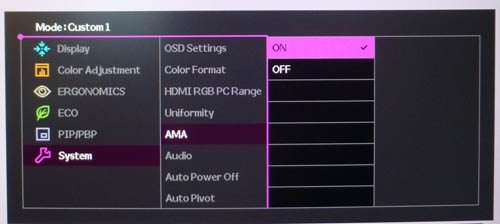
The
part
being used is the
LG.Display LM240WU9 AH-IPS panel. Have a read about response time in
our
specs section if you need additional information about this measurement.
We will first test the screen using our thorough
response time testing method. This uses an oscilloscope and photosensor to
measure the pixel response times across a series of 20 different transitions, in
the full range from 0 (black) to 255 (white). This will give us a realistic view
of how the monitor performs in real life, as opposed to being reliant only on a
manufacturers spec. We can work out the response times for changing between many
different shades, calculate the maximum, minimum and average grey
to grey (G2G) response times, and provide an evaluation of any overshoot present
on the monitor.
We use an
ETC M526
oscilloscope for these measurements along with a custom photosensor device.
Have a read of
our response time measurement article for a full explanation of the testing methodology and reported
data.
AMA Setting Comparison


First of all we carried out a smaller set of
measurements with the AMA setting turned off and then on. With AMA off the
average G2G response time measured in this smaller sample set was 9.6ms. The
overdrive didn't seem to be turned off completely though as we still saw some
moderately high overshoot on some transitions (11.4% for instance when changing
from 50-150). Observing the screen in games and other motion tests showed
moderate levels of blur and some apparent overshoot in certain circumstances.
We then tested the screen with AMA turned on.
Overall the response time had been improved to 8.0ms G2G average, but there was
a much more apparent overshoot problem. More transitions shown here had high
levels of overshoot, even up to 40.8% on 0-150 for instance. In practice there
was a noticeable dark and pale trail behind moving objects which was
distracting. We felt the motion performance was better with AMA left off as the
overshoot was just too severe when it was turned on.

Carrying out simple motion tests using PixPerAn
visually confirmed what we had measured with our oscilloscope. Even in the
limited range of colour transitions shown in the tool you could see some obvious
and pronounced overshoot in the AMA = On setting. A dark and pale trail was
evident and was not something you'd want to contend with for moving content and
gaming.
More Detailed Measurements - AMA OFF
Having established that the AMA off mode seemed to
offer the better response performance because of the lower overshoot we carried
out our normal wider range of measurements as shown below:
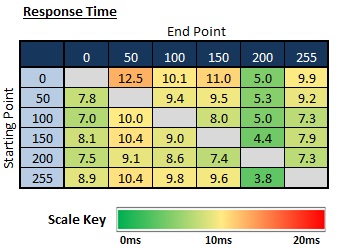
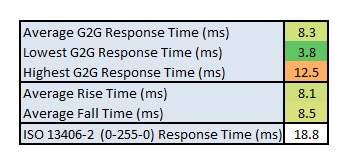
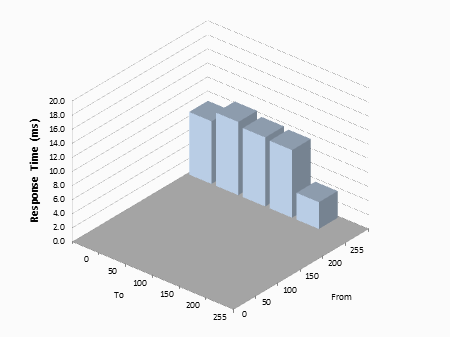
The response time performance overall was actually
a bit better than our initial small sample set, returning a figure of 8.3ms G2G.
This was a little off the specified 5ms G2G, but about normal for a modern IPS
panel really. Some transitions were much faster actually, down to 3.8ms minimum
although not without a resulting overshoot problem unfortunately (see below).
Rise and fall times on average were quite similar as well.
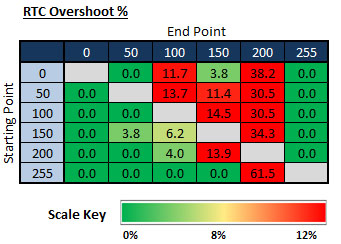
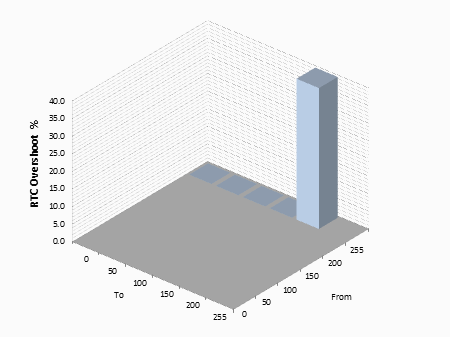
If we evaluate the Response Time Compensation
(RTC) overshoot then the results are not brilliant, even with AMA turned to off.
The transitions which had shown the fastest response times (x - 200), where the
pixel transition was to light grey shades had large amounts of overshoot. The
overdrive impulse was being applied too aggressively to these transitions to
light shades and it was resulting in overshoot around 30 - 35%. Even here with AMA
off there was some noticeable overshoot, particularly on the changes from dark
to light shades (rise times), so you can see why turning it on would just be too
much of an issue. In practice you don't see as much overshoot with AMA Off as
when it's on, although you can see some in certain colour changes.
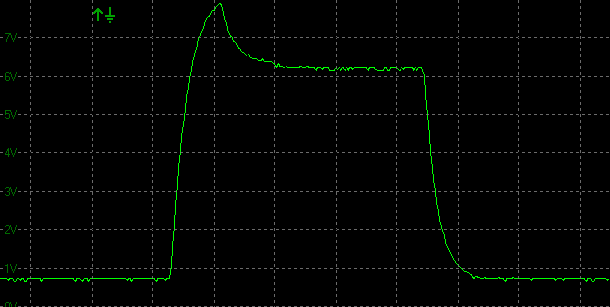
Transition: 50-200-50
(scale = 20ms)
The above oscillogram is an example of the overshoot we saw
where the response times were the fastest.
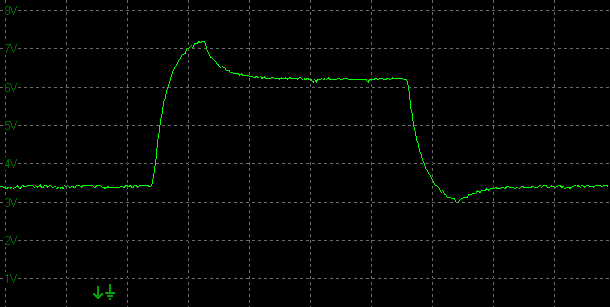
Transition: 150-200-150
(scale = 20ms)
In some cases there was also some overshoot on the
fall times, changes from light to dark shades.
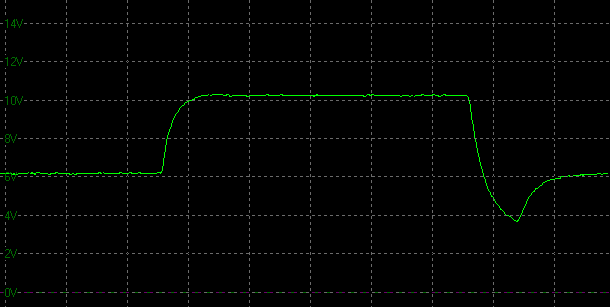
Transition: 200-255-200
(scale = 20ms)
The most severe overshoot measured was when
changing from 255-200 as shown above.
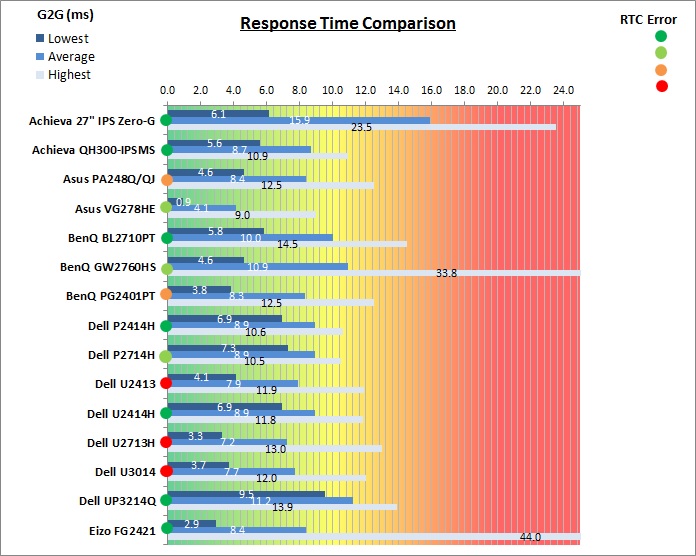
The above comparison chart shows you the lowest,
average and highest G2G response time measurement for each screen we have
measured with our oscilloscope system. As you can see, the PG2401PT performed
much like the other IPS panels we have tested. With an average G2G response time
of 8.3 (this is with AMA set to Off) it was a little faster than models like the
Dell U2414H and P2414H (8.9ms) but did show a much higher level of RTC overshoot
as a side-effect. It does seem that for IPS panels, a G2G response time around
9ms tends to be about as good as you can get without introducing some noticeable
overshoot problems. The Dell U2414H / P2414H models had achieved this without
making the overdrive impulse too aggressive and so showed no obvious overshoot
problems. The Dell U2413/U2713H/U3014 models had pushed response times down to
7.2 - 7.9ms G2G, but at the cost of some very severe overshoot. The BenQ
PG2401PT was somewhere in the middle.
Display Comparisons
The screen was also tested using the chase test in
PixPerAn for the following display comparisons. As a reminder, a series of
pictures are taken on the highest shutter speed and compared, with the best case
example shown on the left, and worst case example on the right. This should only
be used as a rough guide to comparative responsiveness but is handy for a
comparison between different screens and technologies as well as a means to
compare those screens we tested before the introduction of our oscilloscope
method.

24" 5ms G2G
LG.Display AH-IPS (AMA = Off)
In practice the BenQ PG2401PT showed pretty low
levels of motion blur, and no obvious ghosting. There was some some slight
trailing in the best case images as you can see above but overall the movement
felt pretty good. In these specific colour transitions there was no sign of any
obvious overshoot artefacts which was pleasing. We do know though from our
oscilloscope measurements that some transitions did introduce a reasonably high
overshoot, even with AMA turned off. Testing the screen with other motion
content and games did introduce some of this overshoot in certain cases. It was
certainly not as bad as when you have AMA turned on though, which introduced
significant issues even in the PixPerAn tests.
Of course you do need to keep in mind this is an
IPS panel, and so does not feel as snappy as a fast TN Film panel, and cannot
offer the response time of that panel technology either. Other limiting factors
also come into play including the refresh rate (limited to 60Hz here) and motion
blur as a result of eye-tracking and the way LCD monitors operate. For an IPS
panel at 60Hz it is a reasonable result though. We would have liked to see the
overdrive controlled a little better as it was a shame to see there were some
overshoot issues even when AMA was off - it's lowest setting.

24" 5ms G2G
LG.Display AH-IPS (AMA = Off)

23.8" 8ms G2G
LG.Display AH-IPS

23.8" 8ms G2G
LG.Display AH-IPS

24" 6ms G2G AU
Optronics AMVA

24" 8ms G2G
LG.Display e-IPS
We have provided a comparison of the PG2401PT first
of all against 4 of Dell's 24" class screens we have tested. In practice the U2414H and P2414H perform identically,
and were a little faster than the PG2401PT. They were also free from the
overshoot issues we've discussed on the PG2401PT so would be a better choice for
gaming. Of course gaming isn't the target market for the PG2401PT anyway and
you'd be paying well over the odds if you're after a gaming screen if you were
to buy a high end professional grade monitor like this.
The other two models (S2440L and U2412M) showed
low levels of motion blur, comparable to the U2414H and P2414H, but did suffer
from some noticeable overshoot artefacts. There are dark trails behind the
moving car as you can easily see, where the overdrive impulse was being applied
too aggressively.

24" 5ms G2G
LG.Display AH-IPS (AMA = Off)

24"WS 6ms G3G LG.Display e-IPS (Trace Free = 40)

24" 6ms G2G
LG.Display e-IPS (Video OverDrive = On)

24" 4ms G2G AU
Optronics AMVA (AMA = Premium)
We can also compare the PG2401PT against some other
popular 24" models of recent times. You can see that the Asus PA248Q (set at the
optimum 'Trace Free' overdrive setting) performed very similarly to the PG2401PT,
a fact confirmed also by our oscilloscope tests. The HP ZR2440w also showed low
levels of motion blur, but there was some slight dark trailing introduced here. The BenQ GW2450HM's is based on an AMVA panel (as opposed to IPS) and
while it was pretty fast for AMVA technology, it was not as fast as these IPS
models and also showed some fairly noticeable overshoot as well in the form of
dark trails.

24" 5ms G2G
LG.Display AH-IPS (AMA = Off)

24" 6ms G2G
LG.Display AH-IPS

27" 4ms G2G AU
Optronics AHVA (AMA Setting = High)

27" 6ms G2G
LG.Display AH-IPS
We have also provided a comparison of the
PG2401PT above
against 3 other higher end screens. These are models not specifically aimed at
gaming or multimedia, and offer higher end features. The Dell U2413 is perhaps
the PG2401PT's closest rival, featuring the same panel in fact and a similar
feature set. It showed comparable levels of blur in practice, perhaps slightly
faster but not by much. What isn't shown in these particular PixPerAn tests is
that the U2413 had very high levels of overshoot, more so even than the
PG2401PT. The U2713H was a similar story to the U2413, and so overall the
PG2401PT is probably more suited to gaming and dynamic content as the overshoot
is not quite a severe. The BenQ BL2710PT was a tad slower in practice than the
PG2401PT but showed no overshoot problems. It doesn't feature some of the higher
end features of the other models (wide gamut, hardware calibration, uniformity
correction).

24" 5ms G2G
LG.Display AH-IPS (AMA = Off)

27" 2ms G2G Chi
Mei Innolux TN Film +144Hz (Trace Free = 60)

24" 2ms G2G AU
Optronics TN Film + 120Hz (AMA = On)

23.5" 4ms G2G
Sharp MVA + 120Hz
We've also included a comparison above against
3 very fast 120Hz+ compatible screens we have tested. The other screens shown
here are all aimed primarily at gamers and have various features and extras
which make them more suitable overall for gaming.
Firstly there is a comparison against the
Asus VG278HE with its 144Hz refresh
rate and fast response time TN Film panel. This showed very fast pixel response times and smooth movement thanks to
its increased refresh rate. You are able to reduce the motion blur even more
through the use of the LightBoost strobed backlight which we talked about in
depth in our article about
Motion Blur Reduction Backlights.
Then there is a comparison against the
BenQ XL2420T with another very fast TN Film panel and 120Hz refresh rate.
This showed very low levels of motion blur, but some dark overshoot was
introduced as a side-effect. Lastly there is the MVA based Eizo FG2421 screen
with a fast response time (especially for the panel technology being used) and
120Hz refresh rate support. There is also an additional 'Turbo 240' motion blur
reduction mode which really helps reduce the perceived motion blur in practice.
While these pixel response tests from PixPerAn show the
BenQ to
have pretty fast pixel transitions for an IPS panel and in these particular
images there was very little overshoot shown, although we know that there is a
fairly high amount from our oscilloscope measurements, even with AMA set to off.
Beside the response time behaviour, there is something else going on as well here which can't be picked out by the camera. All of these other
gaming models are
running at 120Hz (or higher) refresh rates, which allows for improved 120fps+ frame rates and
in some cases the support of
3D stereoscopic content as well. This can really help improve smoothness and
the overall gaming experience so these screens still have the edge when it comes
to fast gaming. Any additional extras to reduce perceived motion blur can also
have a real benefit in practical terms, and again not easy to pick out with this
camera method.

The responsiveness of the BenQ PG2401PT was
moderate overall. While the average G2G response time was about on par with the faster IPS and PLS models we have tested to
date, there was unfortunately a fairly high degree of overshoot introduced. With
AMA off this was still evident on certain transitions, and you'd certainly want
to avoid AMA on as the overshoot is very apparent. The average 8.3ms G2G response time couldn't of course compete with fast
TN Film models, but for an IPS panel it was good. The screen should be able to handle some
fairly fast
gaming without too much problem, although the overshoot could still be an issue
in some cases. This screen certainly isn't aimed at the gaming market and those wanting to play fast FPS or competitive
games may want to consider some of the more gamer orientated 120Hz+, TN Film
based compatible displays out
there, or perhaps something like the Eizo FG2421. Even better still would be models equipped with
LightBoost systems or other motion blur reduction backlights for optimum motion blur elimination.
BenQ focus their efforts on their XL series when it comes to gaming, so
something like their new XL2420Z or XL2720Z would be more appropriate for
gamers.
On another note many gamers like to use
exaggerated settings to make colours look brighter and more vivid. Wide gamut
screens can serve this purpose well as they natively produces more saturated
colours. This might not be strictly accurate but a lot of people prefer this
more vivid and cartoony appearance and so it's useful that the option is
available from the PG2401PT. There is also an sRGB emulation option if you want
to revert to standard gamut as well.

Additional Gaming Features

Aspect Ratio Control - The screen offers
three options for hardware level aspect ratio control, available within the
'Display' menu as shown above. There are options for 'full' (fill the screen no
matter what the source input resolution/aspect), 'aspect' (fill as much
of the screen as possible while maintaining the source aspect ratio) and 1:1
(direct 1:1 pixel mapping of the source resolution/aspect). This should provide
a good range of scaling options if you need them.
Preset Modes - There is no defined 'game' preset mode available in the menu
as the screen is aimed at high end colour critical work. You can of course set
up one of the custom modes yourself if you want something brighter and perhaps
more vivid for gaming.

Lag
We have written an in depth article about
input lag and the various measurement techniques which are used to evaluate
this aspect of a display. It's important to first of all understand the
different methods available and also what this lag means to you as an end-user.
Input Lag vs. Display Lag vs. Signal
Processing
To avoid confusion with different terminology we
will refer to this section of our reviews as just "lag" from now on, as there
are a few different aspects to consider, and different interpretations of the
term "input lag". We will consider the following points here as much as
possible. The overall "display lag" is the first, that being the delay between
the image being shown on the TFT display and that being shown on a CRT. This is
what many people will know as input lag and originally was the measure made to
explain why the image is a little behind when using a CRT. The older stopwatch
based methods were the common way to measure this in the past, but through
advanced studies have been shown to be quite inaccurate. As a result, more
advanced tools like SMTT provide a method to measure that delay between a TFT
and CRT while removing the inaccuracies of older stopwatch methods.
In reality that lag / delay is caused by a
combination of two things - the signal processing delay caused by the TFT
electronics / scaler, and the response time of the pixels themselves. Most
"input lag" measurements over the years have always been based on the overall
display lag (signal processing + response time) and indeed the SMTT tool is
based on this visual difference between a CRT and TFT and so measures the
overall display lag. In practice the signal processing is the element which
gives the feel of lag to the user, and the response time of course can
impact blurring, and overall image quality in moving scenes. As people become
more aware of lag as a possible issue, we are of course keen to try and
understand the split between the two as much as possible to give a complete
picture.
The signal processing element within that is quite
hard to identify without extremely high end equipment and very complicated
methods. In fact the studies by Thomas Thiemann which really kicked this whole
thing off were based on equipment worth >100,1000 Euro, requiring extremely high
bandwidths and very complicated methods to trigger the correct behaviour and
accurately measure the signal processing on its own. Other techniques which are
being used since are not conducted by Thomas (he is a freelance writer) or based
on this equipment or technique, and may also be subject to other errors or
inaccuracies based on our conversations with him since. It's very hard as a
result to produce a technique which will measure just the signal processing on
its own unfortunately. Many measurement techniques are also not explained and so
it is important to try and get a picture from various sources if possible to
make an informed judgement about a display overall.
For our tests we will continue to use the SMTT
tool to measure the overall "display lag". From there we can use our
oscilloscope system to measure the response time across a wide range of grey to
grey (G2G) transitions as recorded in our
response time
tests. Since SMTT will not include the full response time within its
measurements, after speaking with Thomas further about the situation we will
subtract half of the average G2G response time from the total display lag. This should allow us to give a good estimation of
how much of the overall lag is attributable to the signal processing element on
its own.
Lag Classification
To help in this section we will also introduce a broader classification system
for these results to help categorise each screen as one of the following levels:
-
Class 1)
Less than 16ms / 1 frame lag - should be fine for gamers, even at high levels
-
Class
2)
A lag of 16 -
32ms / One to two frames - moderate lag but should be fine for many gamers.
Caution advised for serious gaming and FPS
-
Class
3)
A lag of more
than 32ms / more than 2 frames - Some noticeable lag in daily usage, not
suitable for high end gaming

For the full reviews of the models compared here and the dates they were written
(and when screens were approximately released to the market), please see our
full
reviews index.
|
(Measurements in ms) |
Standard Mode |
|
Total Display Lag (SMTT
2) |
25.4 |
|
Pixel Response Time
Element |
4.15 |
|
Estimated Signal
Processing Lag |
21.25 |
|
Lag Classification |
2 |
|

Class 2 |
We have provided a comparison above against other
models we have tested to give an indication between screens. Those shown with
blue bars in the bottom half represent the total "display lag" as at the time of
review we did not have access to an oscilloscope system to measure the response
time element and provide an estimation of the signal processing. The screens
tested more recently in the top half are split into two measurements which are
based on our overall display lag tests (using SMTT) and half the average G2G
response time, as measured by the oscilloscope. The response time is split from
the overall display lag and shown on the graph as the green bar. From there, the
signal processing (red bar) can be provided as a good estimation.
The BenQ PG2401PT showed an average total
display lag of 25.4ms during the initial tests. This lag was moderate
overall, equating to around 1.5 frames. We measured half the average G2G
response time as 4.15ms and so we can estimate that the signal processing is
around 21.25ms. The lag is therefore class 2 as described above, although again
the gaming experience is not the focus of a screen like this.

Movies and Video
The following summarises the screens performance
in video applications:
-
24"
screen size makes it a reasonable option for an all-in-one multimedia screen,
but being quite a bit smaller than most modern LCD TV's of course.
-
16:10
aspect ratio is not quite as well suited to videos as a 16:9 format screen, leaving
larger borders on DVD's and wide screen content at the top and bottom.
-
1920 x
1200 resolution can support full 1080 HD resolution content
-
1x HDMI, 1x DisplayPort, 1x
Mini DisplayPort, 1x VGA and 1x DVI connections. Decent choices for modern DVD
players, Blu-ray, consoles etc. Good to see HDMI included here.
-
Cables provided in the box
for everything except
HDMI.
-
Light
AG coating a positive change from older IPS panels providing clean and clear images, without the
unwanted reflections of a glossy solution.
-
Wide
brightness adjustment range possible from the display, including high maximum
luminance of ~314
cd/m2, but a minimum reduction of
only ~109 cd/m2. This should afford you very good control for different
lighting conditions although for darker ambient lighting the minimum
adjustment is limited. Turning on the uniformity compensation feature can
allow for a lower minimum luminance (down to around 63 cd/m2) but
at the cost of a reduced contrast ratio.
-
Contrast ratio remains stable across that
adjustment range as well, but the backlight uses PWM for dimming control,
albeit at a high frequency and low amplitude.
-
Black
depth and contrast ratio are moderate for an IPS panel at around 710:1 after
calibration. Detail in darker scenes should not be lost though, and
shadow detail should be reasonable.
-
Dynamic contrast ratio is not featured on this model.
-
There
are no specific 'movie' preset modes available for movies or video so you will
need to set up one of the custom modes if you want something specific for your
movie viewing.
-
Good
pixel responsiveness which should still be able to handle fast moving scenes
in movies without issue. Some overshoot problems on certain transitions even
with AMA off. Don't turn AMA on unless you want severe and very noticeable
overshoot.
-
Wide viewing angles thanks to IPS panel
technology meaning several people could view the screen at once comfortable
and from a whole host of different angles. IPS glow is present at typical
levels which may be distracting with darker content form an angle.
-
Very good and easy to use range of ergonomic
adjustments available from the stand, so should be easy to obtain a
comfortable position for multiple users or if you want to sit further away
from the screen for movie viewing.
-
No
particularly noticeable backlight leakage, although there was some clouding
from some of the corners. Thankfully there was none from the edges which is good. This type
of leakage may prove an issue when watching movies where black borders are
present but it is not a problem here.
-
No
integrated stereo speakers on this model.
-
Good
range of
hardware aspect ratio options with full, aspect and 1:1 modes available which
should be fine for most uses.
-
Picture in picture (PiP) and Picture By Picture (PbP) are available on this
model for those who need them.

Conclusion
The PG2401PT overall was an impressive screen,
especially considering it is BenQ's first venture into the professional colour
enthusiast market. The screen certainly offered just about every feature and
extra that you could want or need from a high end screen which was very
pleasing. The stand was versatile and offered great adjustment choices, there
are the useful ambient light sensor, human motion sensor, USB 3.0 ports and
8-in-1 card reader too. There are a very wide range of connectivity options,
with cables provided for nearly all of them in the box, a monitor hood,
touch-sensitive operational buttons, hardware calibration support, factory
calibrated preset modes and even a very effective uniformity compensation
feature.
Extras aside, the IPS panel offered some
very good all round performance in most areas. The GB-r-LED backlight offers a
wide gamut for those wanting to work in Adobe RGB and other wide colour spaces.
There's also a reliable and very well set up sRGB emulation mode if you prefer.
10-bit support is offered from the panel for those with a compatible workflow
and the IPS technology itself provides stable and reliable colours from a wide
variety of angles.
There are a few areas which were a little limited
though, perhaps room for improvement for future releases in this range. The
contrast ratio of the display is only moderate for IPS at around 710:1 after
calibration, but perhaps a limitation of the actual LG.Display panel as we'd
seen similar from the Dell U2413 screen. The brightness adjustment range was
limited at the lower end which could be an issue for some, and the PWM usage may
put off some buyers. Having said that, using the uniformity compensation option
helps with brightness range and the PWM frequency is very high so it is unlikely
to be as problematic as common low frequency PWM usage. The response times were
decent for an IPS panel but even with AMA turned off there were some overshoot
issues which could be problematic for any gaming. We would like to see more
control over the AMA feature perhaps if possible. Gaming isn't the intended
usage for the PG2401PT so we won't worry too much about that or the moderate
levels of display lag either. While the hardware calibration software was very
good and offered a lot of options, the lack of brightness control from the OSD
afterwards was annoying and the calibration process itself takes a long time.
What you do get from the BenQ PG2401PT is a very
capable monitor with an excellent default setup and a massive range of features,
extras and options to play with.
|
Pros |
Cons |
|
Excellent factory calibration
and setup |
PWM used although at high
frequency |
|
Massive range of connections,
extras and features |
Limited lower brightness
adjustment range |
|
Decent uniformity compensation
function |
Some overshoot issues with
response times, even with AMA off. |
|
 |
If you have enjoyed
this review and found it useful, please consider making a
small
donation to the site. |